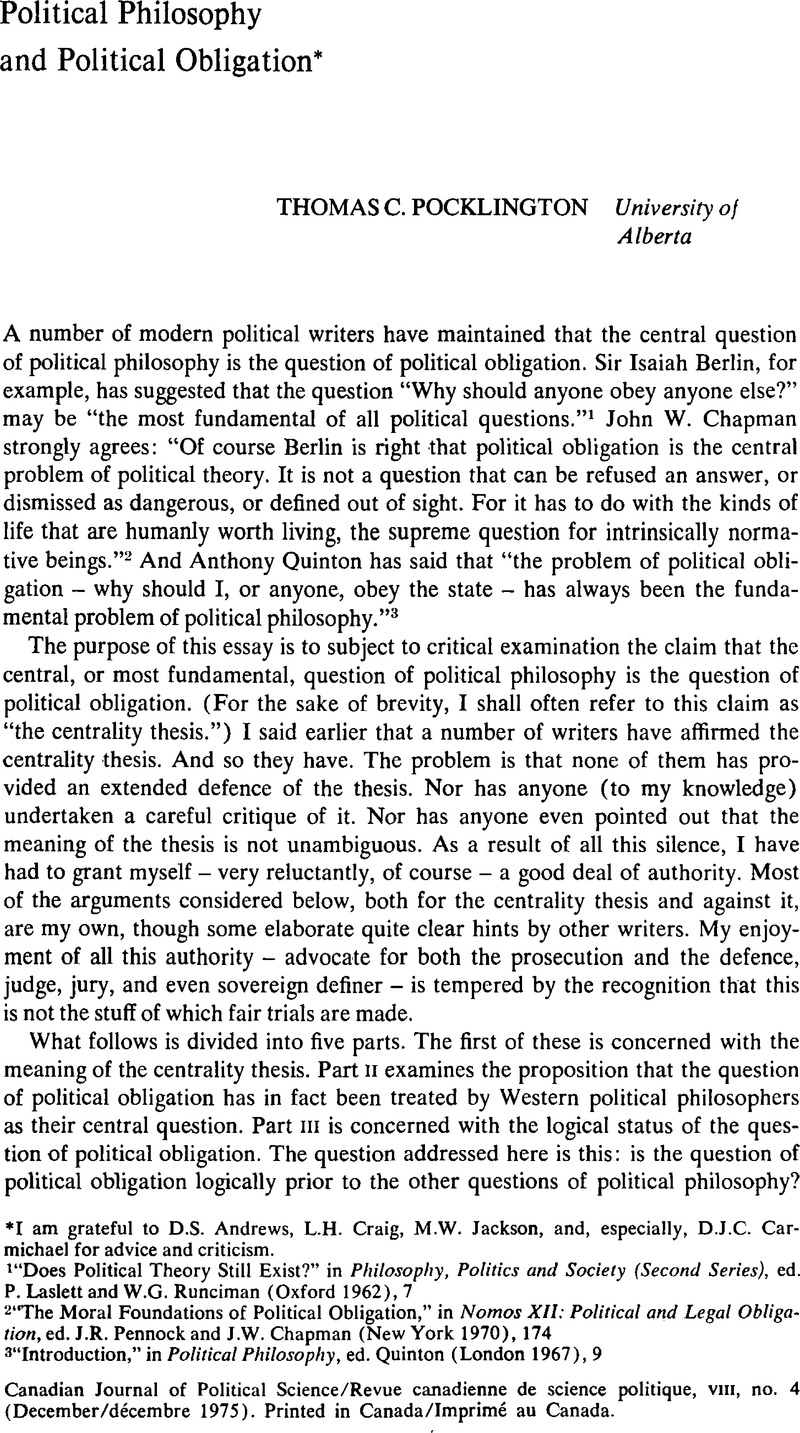Published online by Cambridge University Press: 10 November 2009

1 “Does Political Theory Still Exist?” in Philosophy, Politics and Society (Second Series), ed. P. Laslett and W.G. Runciman (Oxford ), 7
2 “The Moral Foundations of Political Obligation,” in Nomos XII: Political and Legal Obligation, ed. Pennock, J.R. and Chapman, J.W. (New York 1970), 174Google Scholar
3 “Introduction,” in Political Philosophy, ed. Quinton, (London 1967), 9Google Scholar
4 Or: Why should anyone obey the state, or the law, or the sovereign?
5 “Obligation and Consent – I,” American Political Science Review, LIX (December 1965), 990–9
6 Ibid., 990–1
7 Ibid., 991
8 Note that, on this understanding, not all questions of politial obligation are questions of obligation in a narrow sense of that word. A distinction between a broad and a narrow sense of political obligation is discussed in Pocklington, Thomas, “Protest, Resistance, and Political Obligation,” this journal, III, no. 1 (March 1970), 2–4.Google Scholar See also Ladd, John, “Legal and Moral Obligation,” in Nomos XII: Political and Legal Obligation, ed. Pennock, J.R. and Chapman, J.W. (New York 1970), 7–9.Google Scholar
9 “The Language of Political Theory,” in Essays in Logic and Language, ed. Flew, Anthony (Oxford 1951), 183–4Google Scholar
10 Ibid., 177
11 For example, Bentham in the first and fourth chapters of A Fragment on Government and Mill in the final chapter of Utilitarianism
12 This suggests a third line of attack on the argument under examination, namely, one that challenges the presupposition that government is definitive of politics.
13 (New York 1970), vii
14 Ibid., 12–18
15 More honest, of course, because it does not presume that the question can be given a satisfactory answer.
16 Ibid., 12
17 Ibid., 15–16, 18
18 I hope it is clear that the analysis in the text is not meant to be a refutation of anarchism. The argument is simply that the issue between the anarchist and his opponent is a substantive one, not to be settled by a tendentious definition of “obedience.”
19 Needless to say, the revolutionary and the tory will disagree not only as to the nature of well-being, but also as to the relationship between well-being and obedience. The tory will hold that well-being is promoted by the most scrupulous obedience, whereas the revolutionary will hold that obedience is the most formidable obstacle to well-being. The point is that they could agree as to the importance of obeying and disobeying.
20 It is understood throughout, of course, that it is not the questions themselves that are deemed important, but the results of acting on various answers to them.
21 (London 1967), 41
22 Ibid., 42
23 Ibid.
24 Ibid., 43
25 Ibid., 44
26 Ibid., 43
27 It may be noted that I speak of “individualism or liberalism” where McPherson speaks only of individualism. There are two reasons for this. The first is that the individualistic political philosophers McPherson refers to (Locke is his main example) are evidently liberal individualists. The second is that Alan P. Wertheimer, supporting McPherson's position, speaks of “an individualistic or liberal perspective.” See Wertheimer, , “Political Coercion and Political Obligation,” Nomos XIV: Coercion, ed. Pennock, J.R. and Chapman, J.W. (New York 1972), 214.Google Scholar